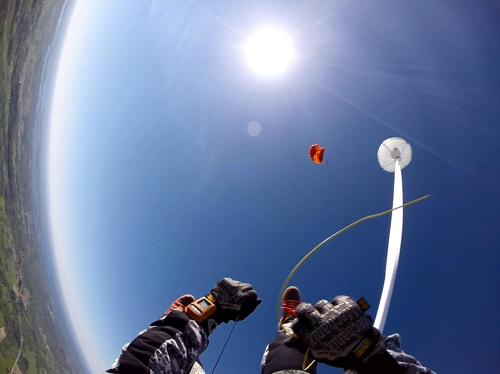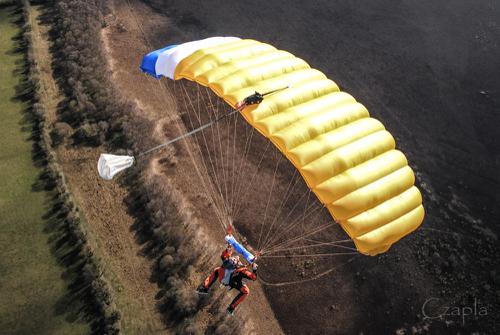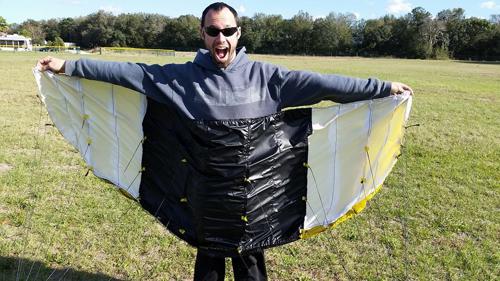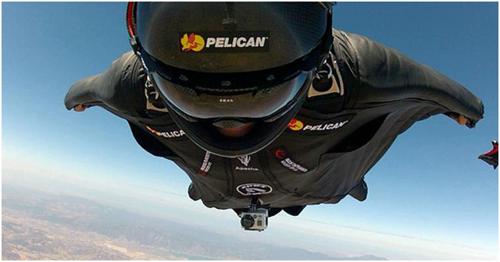Image by Mike Barta
So…you just crushed an 8-way angle jump, stacked tight and flying fast. Damn that feels good. Or maybe it was a Sunday night sunset BFR with all the sky-fam that stuck around till the very end of another awesome weekend at the dropzone. Perfect! Or maybe you’re six jumps into a busy day, flying camera for tandems, and you’ve just finished break-off and are watching that giant tandem wing smack open as you sink away. Whichever it is, if what happens next involves a turbulent mess of canopy flapping and flailing above you, or spinning-you-up violently beneath it, its decision time…and fast.
But, if you’re anything like me, and find that in that moment your brain is still rapidly processing the various factors in play (as opposed to immediately switching into survival mode and initiating an instinctual, muscle-memory-based set of EPs), it’s possible that one of your first thoughts will be “is my RSL connected”? And, if so, “if I chop this, is my reserve headed directly into this bag of shit as it deploys”?
I’ve only personally dealt with this scenario twice. The most recent occurred under a rapidly spinning mal while wearing a (small-ish) wingsuit and flying what most would consider an inappropriate canopy for wingsuit skydiving (my bad, I know). And while my canopy choice may have been shameful, I’m not ashamed to say that this experience had my heart rate pounding…but not because of the malfunction. And not even because of the violent spinning and inevitable disorientation. I quickly realized that I hadn’t disconnected my RSL – which I typically do when flying my wingsuit – and was afraid that if I employed my standard emergency procedures my main and my reserve were about to get really friendly with one-another.
Luckily, that didn’t happen, and I lived to fly another day (under a much safer and more suitable wing I might add). However, since that experience, I’ve spent a lot of time thinking about and discussing the use of RSLs and Skyhooks with jumpers of all ages and disciplines, wherever I fly. And while there is no debate that both RSL and Skyhook technology save invaluable time and altitude in many malfunction situations – and there is ample data available to prove just that – their use remains a polarizing issue, with certain skydiving disciplines disproportionately biased for, or against, the use of these now-standard safety features.
If you don’t believe me (or perhaps had never given it much thought) take a look around the next time you’re at a big dz and take note of who’s using RSLs and who isn’t…and what type of flying it seems like they’re doing. You may be surprised at what you observe. Or, if you’re even braver, try bringing it up around the campfire or at the bar after a few post-jump beverages. Warning: be prepared for the shit-storm you may have just lit.
At any rate, to better present both sides of this debate, I asked a few friends to share their views and their own reasoning as to why they choose to use, or shun, RSLs and Skyhooks. What follows is a series of brief quotes and explanations from these conversations.
Justin Price – Justin is a PD Factory Team member, a Flight 1 instructor, and a world-class canopy pilot who competes at the pinnacle of the sport.
JP: “I think the Skyhook and RSL are great backup devices for the everyday skydiver. However, if you are jumping a highly loaded canopy (2.8 range or higher) having a skyhook could lead to some unforeseen malfunctions. I don't believe the manufacturers have done any real testing with canopies loaded this much having spinning malfunctions with the Skyhook. I have seen 1 skyhook reserve deployment from a spinning canopy loaded around 3.0 where an entanglement could be present.”
Image by Mike McGowen
Think about the configuration of a skyhook deployment, you have the malfunctioning canopy at the apex attached to the bridle with a free bag, still with the locking stows, on one side of the bridle and the spring loaded pilot chute on the other side. Now as the spinning main is deploying the system there seems to be the possibility of the main spinning violently enough to have the reserve pilot chute wrap underneath the free bag trapping the locking stow from coming out. So until some real testing has been done proving that this is not possible I’m not going to be the first skydiver to have that malfunction while doing hop n pops or if jumping something loaded that high.”
Sandy Grillet – Sandy is a very prominent sales rep for UPT, who’s also recognized to be among the best belly organizers in the biz. He has decades in the sport and his skydiving resume speaks for itself.
Sandy: “OK - in the last 5 years I lost two really good friends because they had the same thoughts as you. One of them had a spinner out of control and before he could get cutaway hit another jumper under canopy. He ended up cutting away still high enough to get a reserve but not high enough to reactivate his AAD. He pulled just high enough to go-in at line stretch. We believe the body-to-body collision under canopy dazed him enough to slow his reflexes on both the cutaway and the reserve pull.
Image by Henrik Csuri
The sad thing is that he and I had an hour long conversation about Skyhooks and RSLs 10 days before. The guy he hit was another friend of ours and he is convinced a Skyhook would have saved him. I've lost a lot of friends over the years but that one was tough to wrap my mind around.
I truly believe that if more people understood the physics behind what happens during normal cutaways without RSLs - cutaways with normal RSLs and then cutaways with Skyhooks - everyone would use them. As you said, it’s personal preference. I would be happy to have another conversation with you to give my perspective of the physics.”
Scotty Bob – Scotty likely needs very little introduction. His exploits in wingsuit BASE are accessible and heavily viewed online by skydivers, BASE jumpers, and whuffos alike. And his current involvement with wingsuit skydive coaching (both as a load organizer, private coach, and now most recently with Squirrel’s ‘Next Level’ program) has him bouncing from one dz to the next – along with his crew of usual suspects – to help raise the next generation of little birdies right.
Image by Dan Dupuis
Scotty: “They are a great idea, and have definitely added to the safety net, especially for younger jumpers. That being said, their use should not be mandatory due to the ever changing aspects of our sport. The option to be in direct control of one’s emergency procedures from start to finish should be in the hands of each individual jumper, not a blanket rule.
I currently do not use an RSL. I want to activate my reserve opening with my reserve handle. Just a personal preference.”
Anthony TJ Landgren – TJ is an all-around badass. There is very little at which he doesn’t excel in the worlds of canopy sport and body-flight. He’s an OG swooper, a wingsuit ninja, an elite tunnel coach, and now a highly sought-after XRW guru.
TJ: “Over the years a lot of people asked me would I, or have I ever, jumped with an RSL? My answer is yes I have jumped an RSL, but only for 1000 jumps or so. I had an RSL back when I jumped a Sabre. I was told that RSLs are great when you are new in the sport and as an extra safety precaution.
Once I started jumping a Stiletto, I was told they can cause more harm than good. Stilettos were the first fully elliptical canopy and they were awesome. The only problem was that if you got line twist it was a bitch to get out of them because the canopy will dive and pick up more speed. I had a really low chop when I had 2000 jumps on a stiletto 135, I was spinning hard once I cut away I needed to get away from the canopy and open my reserve. I was so happy not to have an RSL because two weeks prior to that my friend Cris cut away a stiletto 150 with an RSL and he had 4 line twist on his reserve and barely time to get out of his reserve line twist before hitting the ground. That's when I knew I would never use an RSL ever again.
Image by Raymond Adams
I believe in pulling a bit higher so that I have more time to deal with a malfunctioning parachute. I feel RSLs and Skyhooks give people false security in pulling low, which I try to avoid. I was told that when dealing with a malfunction: check your altitude, deal with the situation, and always have hard deck that you know you can't fix this malfunctioning parachute and it's time to get rid of it.
I have 16 cutaways in over 26,000 jumps and 1 was an RSL save (not by choice).
I Believe people that have over 1000 jumps or jump a high performance canopy should really think about whether an RSL is going to help, or if it will only make things worse. I hope this help you to make an educated decision about RSLs and Skyhooks.”
Will McCarthy – Will is the closest thing here to an “average” skydiver. Although, having grown up on a dz, and grown into the DZO of my favorite dropzone in Canada (Skydive Gananoque), he’s been around the sport long enough to know and have seen a thing or two. Most days, Will is hucking drogues and/or flying camera, but he’s done it all over the years – from AFFI, to belly big-ways, to wingsuit, to CRW and swooping.
Will: “As a DZO and our S&TA;, my reply is always, it depends. For people learning to skydive, including tandem students, I think they're a great legal out, as in "we use every piece of safety equipment available". And if you're going to use an RSL, spend the extra money and get a MARD/Skyhook. For experienced skydivers, I personally feel that the use of an RSL or MARD/Skyhook system unintentionally promotes complacency.
Image by Justin Dempsey
The number of times I've personally seen an incorrectly routed/assembled RSL leads me to believe that the complacency is getting worse. People are afraid of doing anything to their gear, (assembly or even packing it, in a lot of cases) and a blind faith in the technology increases the risk that when something outside a "normal" malfunction occurs, it won't be handled correctly.
I don't use one unless I'm jumping a tandem rig. But we also don't allow them to be used on paid camera slots or CRW jumps, either.”
My final thoughts on this reflect much of what was said above. Both of my rigs have an RSL because I like to have the option of using it for specific types of jumping. While I hate to admit it, there are certain jumps where I know that I’m going to be pulling lower than usual – flying my tracking suit solo on a hop-and-pop is one such example. And in situations like that, where I’m under a Sabre 150 and feel pretty confident that it’s not gonna spin-up-on-me or toss-me-around violently, I like the comfort of knowing that if I do have to chop, my RSL will likely save me some valuable altitude. However, when I slap on the big wingsuit, I feel far less comfortable having the RSL connected. In that instance, I make sure to disconnect it and secure it (safely and correctly) to the cable housing. Also, as TJ similarly pointed out, I’ll be deliberately pulling higher on big wingsuit flights so that I have ample altitude to deal with, and separate myself from, any malfunctions that might arise.
Hopefully reading this will have given you cause to consider where you’re at in your own jumping – taking into account an honest self-assessment of your level of skills and experience – but also your specific discipline(s) of choice and, thus, what makes the most sense for you. To borrow a mantra from wingsuit BASE, a safe-bet for many styles of jumping is fly fast and pull high. If you can abide by those two tenets, regardless of your choice as to whether or not to use an RSL, you’ll be all-the-better for it.
Stay safe folks.









